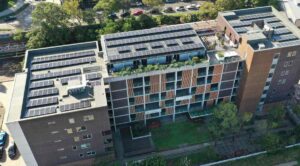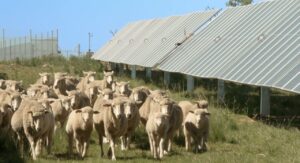Bellevue Gold is aiming to become Australia’s first publicly-listed gold miner to generate net-zero emissions, saying it will sell its “green gold” at a premium while slashing energy costs with renewables.
Bellevue announced on Monday it had signed an agreement with sustainable distributed energy provider Energy Developments Pty Ltd (EDL) for an off-grid hybrid wind, solar and battery-backed power station to be built at its gold mine in Western Australia.
The hybrid power solution, while not yet finalised, will use the combination of renewables and battery storage to supply an average of 80% of the site’s power requirement of around 13MW, the company says, factoring in some gas power back-up.
But EDL says the hybrid power solution incorporating wind, solar and battery storage will enable regular bouts of 100% renewable energy operation, with all thermal generators turned off when not required.
EDL already owns and operates a similar turnkey micro-grid at the Agnew gold mine 35km south of Bellevue’s mine, which was commissioned last year by Gold Fields of South Africa. Gold Fields has committed to cut net carbon emissions by 30 per cent at its mines in South Africa, Australia and Latin America by 2030.
By reducing greenhouse gas emissions with a renewable energy power station and undertaking other sustainable initiatives, Bellevue believes it can extract carbon-neutral gold, giving it a major competitive advantage in global investment markets, where pressure is mounting for companies offering stock to reduce their carbon footprints.
“Bellevue is forecast to be 200,000 ounces a year gold miner… powered by 80 per cent renewable energy, with a pathway to net zero emissions as a world-leading company in the race to decarbonise the mining sector,” managing director Steve Parsons said.
Parsons said Bellevue’s pre-production carbon mitigation strategy has been “strategic” and “world leading,” achieving the “holy grail’” of lower emissions and a direct cost reduction in power generation.
“The combination of these metrics is expected to position Bellevue as one of the most sustainable and financially successful Australian gold miners, maximising returns for all stakeholders,” he said.
“It will also underpin the company’s strong appeal to global investors, who demand performance on both financial and ESG measures.”
A growing number of investors have been seeking to quantify the climate implications of investment holdings by using what is called the “temperature rating” or “warming potential” of a portfolio. This offers a high-level indication of what portfolio holdings imply for the global temperature projected to 2100.
Bellevue and EDL are now negotiating a power purchase agreement for the project, which is subject to approval by the boards of both companies.
The EDL-built power station will prioritise the use of renewable energy, but will also include a gas engine configuration, which will ensure there is always sufficient power for the mine, even in the rare absence of solar and wind resources, according to Parsons
EDL will supply trucked-in gas to the mine to “maintain optionality for any future technological innovations in thermal generation alternative fuels,” he said.
Renewable energy is expected to meet up to 80 percent of the mine’s annual electricity needs, taking advantage of the region’s strong solar and wind resources.
Bellevue has been modelling the wind speeds and direction with SODAR – meteorological instrument used as a wind profiler – which has allowed for the integration of wind turbines to increase the renewable energy penetration rate.
Maximising renewable energy uptake has been a key design consideration for the processing facility. The facility will have the ability to use more power – such as crushing and heating – when increased renewable energy is available, reducing thermal requirements, according to Parsons.
The design gives Bellevue a cost-effective renewable energy supply and optimises the power demand curve to better align with key daytime solar and night-time wind energy peaks and troughs.
Parsons sees this as potentially offsetting more than 1MW in demand on thermal power generation and lead to a direct cost saving and emissions reduction.










